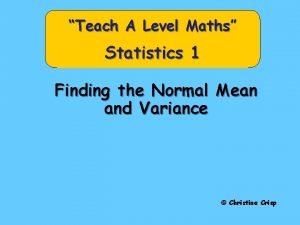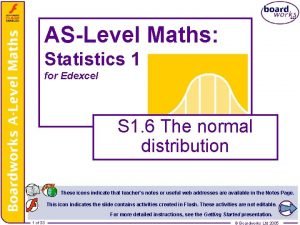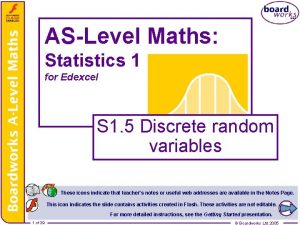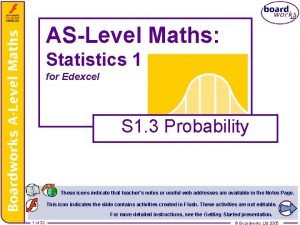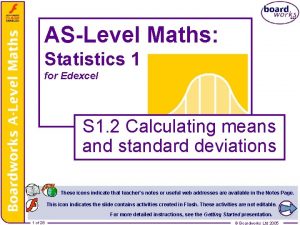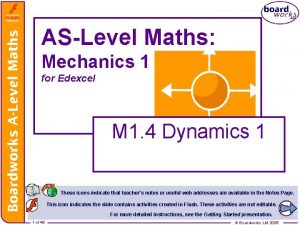ASLevel Maths Statistics 1 for Edexcel S 1



































- Slides: 35

AS-Level Maths: Statistics 1 for Edexcel S 1. 1 Representation and summary of data This icon indicates the slide contains activities created in Flash. These activities are not editable. For more detailed instructions, see the Getting Started presentation. 11 of of 35 35 © Boardworks Ltd 2005

Graphical representations of data Contents Simple graphical representations of data: histograms, stem-and-leaf diagrams, quartiles and box plots Outliers Cumulative frequency diagrams and linear interpolation 22 of of 35 35 © Boardworks Ltd 2005

Histograms A histogram can be used to display grouped continuous data. There are some important points to remember: The area of each bar in a histogram should be in proportion to the frequency. When the class widths are not all equal, proportional areas can be achieved by plotting the frequency density on the vertical axis, where The class width of an interval is calculated as the difference between the smallest and largest values that could occur in that interval. 3 of 35 © Boardworks Ltd 2005

Histograms Example: 50 overweight adults tested a new diet. The table shows the amount of weight they lost (in kg) in 6 months. Weight loss (kg) Frequency 0– 4 4– 6 6– 8 8 – 10 10 – 15 15 – 25 12 13 11 7 5 2 4 of 35 Class width Frequency density 4 Notice that the 3. 0 class all 2 widths are not 6. 5 equal – frequency 2 densities need to 5. 5 2 be used. 3. 5 5 1 10 0. 2 © Boardworks Ltd 2005

Histograms Weight loss (kg) Frequency density 0– 4 3. 0 4– 6 6. 5 6– 8 5. 5 8 – 10 3. 5 10 – 15 1 15 – 25 0. 2 Histogram to show weight loss When you draw a histogram, remember to: plot the frequency densities on the vertical axis; choose sensible scales for your axes; label both your axes; give the histogram a title. 5 of 35 © Boardworks Ltd 2005

Histograms Histogram to show weight loss We can use the histogram to estimate, for example, the number of people who lost at least 12 kg: There were 2 people who lost between 15 and 25 kg. To estimate how many people lost between 12 and 15 kg, times this new class width by the frequency density for that class: 3 × 1 = 3. That means that about 5 people lost at least 12 kg. 6 of 35 © Boardworks Ltd 2005

Histograms Example: An ornithologist measures the wing spans (to the nearest mm) of 40 adult robins. Her results are shown below. Actual interval Freq. density Wing span (mm) Frequency 195 - 204 8 205 – 209 9 210 – 214 11 215 – 224 9 The measurements are to the nearest millimetre. 204. 5 1. 8 are –to 209. 5 the nearest millimetre. The first interval actually contains first interval contains 209. 5 The 214. 5 2. 2 all–wing spans between all wing spans between 194. 5 and 204. 5 mm 214. 5 – 224. 5 0. 9 194. 5 and 204. 5 mm 225 or over 3 224. 5 – 244. 5 194. 5 –The 204. 5 measurements 0. 8 0. 15 The last interval is open-ended. We assume that its width is twice that of the previous interval. 7 of 35 © Boardworks Ltd 2005

Histograms Example (continued) Interval 194. 5 – 204. 5 – 209. 5 – 214. 5 – 224. 5 – 244. 5 Freq. density 0. 8 1. 8 2. 2 0. 9 0. 15 Freq. density A histogram showing the wing spans of robins Wing span (mm) 8 of 35 © Boardworks Ltd 2005

Stem-and-leaf diagrams are a simple way of showing a set of data graphically. They are formed by splitting each data value into two parts. The first part of the number forms the stem and the second part, the leaf. Example: A group of 25 people took part in a general knowledge quiz. Their scores are recorded below: 22, 47, 43, 38, 52, 45, 43, 29, 49, 35, 37, 48, 17, 61, 50, 48, 42, 34, 37, 40, 45, 57, 38, 54, 29 Each number naturally splits into 2 parts – the tens digit and the units digit. 9 of 35 © Boardworks Ltd 2005

Stem-and-leaf diagrams are useful as they contain the same degree of accuracy as the original data. 10 of 35 © Boardworks Ltd 2005

Stem-and-leaf diagrams It is sometimes necessary to split the contents of each leaf over two rows. Example: The times (in seconds) taken to run the 400 m by 20 female competitors in the 2004 Olympic Games were: 50. 2, 51. 5, 50. 2, 51. 0, 50. 5, 51. 4, 51. 3, 52. 2, 50. 0, 50. 6, 52. 0, 51. 8, 51. 6, 51. 2, 51. 9, 50. 1, 49. 9, 52. 6, 51. 4, 51. 6. These values can be plotted in a stem-and-leaf diagram: When splitting rows, the top row should contain the digits 0, 1, 2, 3 and 4. Higher digits are put on the second row. 11 of 35 49 | 9 means 49. 9 secs 49 9 50 0 1 2 2 50 5 6 51 0 2 3 4 4 51 5 6 6 8 9 52 0 2 52 6 Stem-andleaf diagram of times in the 400 m © Boardworks Ltd 2005

Stem-and-leaf diagrams can be used to compare two sets of data. The back-to-back stem-and-leaf diagram shown below compares the height of 15 boys and 12 girls from a form group. A stem-and-leaf diagram comparing the heights of pupils in a form group The diagram shows that the boys in the form group are typically taller than the girls. The heights of the boys are also more varied than the girls’ heights. A more formal comparison of the heights can be made using the median and the inter-quartile range. 12 of 35 © Boardworks Ltd 2005

Quartiles and box plots A set of data can be summarised using 5 key statistics: the median value (denoted Q 2) – this is the middle number once the data has been written in order. If there are n numbers in order, the median lies in position ½ (n + 1). the lower quartile (Q 1) – this value lies one quarter of the way through the ordered data; the upper quartile (Q 3) – this lies three quarters of the way through the distribution. the smallest value, and the largest value. 13 of 35 © Boardworks Ltd 2005

Quartiles and box plots These five numbers can be shown on a simple diagram known as a box-and-whisker plot (or box plot): Smallest value Q 1 Q 2 Q 3 Largest value Note: The box width is the inter-quartile range. Inter-quartile range = Q 3 – Q 1 The inter-quartile range is a measure of spread. The semi-inter-quartile range = ½ (Q 3 – Q 1). 14 of 35 © Boardworks Ltd 2005

Quartiles and box plots Example: The (ordered) ages of 15 brides marrying at a registry office one month in 1991 were: 18, 20, 22, 23, 25, 26, 29, 30, 32, 34, 38, 44, 53 The median is the ½(15 + 1) = 8 th number. So, Q 2 = 26. The lower quartile is the median of the numbers below Q 2. So, Q 1 = 22. The upper quartile is the median of the numbers above Q 2. So, Q 3 = 34. The smallest and largest numbers are 18 and 53. 15 of 35 © Boardworks Ltd 2005

Quartiles and box plots The (ordered) ages of 12 brides marrying at the registry office in the same month in 2005 were: 21, 24, 25, 27, 28, 31, 34, 37, 43, 47, 61 Q 2 is half-way between the 6 th and 7 th numbers: Q 2 = 29. 5. Q 1 is the median of the smallest 6 numbers: Q 1 = 25. Q 3 is the median of the highest 6 numbers: Q 3 = 40. The smallest and highest numbers are 21 and 61. 16 of 35 © Boardworks Ltd 2005

Quartiles and box plots A box plot to compare the ages of brides in 1991 and 2005 We can use the box plots to compare the two distributions. It is important The median values show that the brides in that 1991 thewere two box plots are drawn generally younger than in 2005. on the same The inter-quartile range was larger in 2005 meaning that scale. there was greater variation in the ages of brides in 2005. Note: When asked to compare data, always write your comparisons in the context of the question. 17 of 35 © Boardworks Ltd 2005

Shapes of distributions Box plots are useful because they make comparing the location, spread and the shape of distributions easy. A distribution is roughly symmetrical if Q 2 – Q 1 ≈ Q 3 – Q 2 A distribution is positively skewed if Q 2 – Q 1 < Q 3 – Q 2 A distribution is negatively skewed if Q 2 – Q 1 > Q 3 – Q 2 18 of 35 © Boardworks Ltd 2005

Examination-style question: A survey was carried out into the speed of traffic (in mph) on a main road at two times: 8 a. m. and 11 a. m. The speeds of 25 cars were recorded at each time and displayed in a stem-and-leaf diagram: A stem-and-leaf diagram to show vehicle speed on a main road a) Find the median and the inter-quartile range for the traffic speeds at both 8 a. m. and 11 a. m. b) Draw box plots for the two sets of data and compare the speeds of the traffic at the two times. 19 of 35 © Boardworks Ltd 2005

Examination-style question As speeds from 25 vehicles were measured, the median would be the 13 th value. 8 a. m. 11 a. m. The L. Q. would be the median of the smallest 12 values. The U. Q. would be the median of the largest 12 values. 20 of 35 Q 2 43 51 Q 1 34 42 Q 3 49 60 IQR 15 18 © Boardworks Ltd 2005

Examination-style question 8 a. m. 11 a. m. Q 2 43 51 Q 1 34 42 Q 3 49 60 IQR 15 18 A box plot comparing vehicle speed at 8 a. m. and 11 a. m. The box plots show that traffic speed is generally slower at 8 a. m. than at 11 a. m. The inter-quartile ranges show that there is greater variation in the traffic speed at 11 a. m. than at 8 a. m. Notice that the speeds at 8 a. m. have a negative skew, whilst the speeds at 11 a. m. are roughly symmetrically distributed. 21 of 35 © Boardworks Ltd 2005

Outliers Contents Simple graphical representations of data: histograms, stem-and-leaf diagrams, quartiles and box plots Outliers Cumulative frequency diagrams and linear interpolation 22 22 of of 35 35 © Boardworks Ltd 2005

Outliers An item of data that is unusually small or unusually large is classed as an anomaly or an outlier. An outlier could occur as the result of an error (e. g. a measuring or recording error). The outlier might however be a true value that just happens to be very different from the rest. A simple rule that is often used is to identify points that are smaller than (Q 1 – 1. 5 × IQR) or greater than (Q 3 + 1. 5 × IQR) as outliers. Outliers can be marked on a box plot with an asterisk. * 23 of 35 © Boardworks Ltd 2005

Outliers Example: The annual salaries (in thousands of pounds) of 10 employees of a small company are: 12, 14, 17, 20, 21, 22, 23, 27, 58. The median salary is half-way between the 5 th and 6 th values, i. e. Q 2 = 20. 5 (or £ 20, 500). The lower quartile is the median of the lowest 5 values, i. e. Q 1 = 17 (or £ 17, 000). The upper quartile is the median of the largest 5 values, i. e. Q 3 = 23 (or £ 23, 000). The IQR is 23 – 17 = 6. 24 of 35 © Boardworks Ltd 2005

Outliers Example (continued): An outlier would be a value less than or a value more than (Q 1 – 1. 5 × IQR) 17 – 1. 5 × 6 = 8 (Q 3 + 1. 5 × IQR) 23 + 1. 5 × 6 = 32. So the value 58 is an outlier. 25 of 35 © Boardworks Ltd 2005

Cumulative frequency diagrams Contents Simple graphical representations of data: histograms, stem-and-leaf diagrams, quartiles and box plots Outliers Cumulative frequency diagrams and linear interpolation 26 26 of of 35 35 © Boardworks Ltd 2005

Cumulative frequency diagrams A cumulative frequency diagram is useful for finding the median and the quartiles from data given in a grouped frequency table. There are some important points to remember: the cumulative frequencies should be plotted above the upper class boundaries of the intervals – don’t use the mid-points can be joined by a straight line (for a cumulative frequency polygon) or by a curve (for a cumulative frequency curve). 27 of 35 A cumulative frequency polygon © Boardworks Ltd 2005

Cumulative frequency diagrams Example: A survey was carried out into the number of hours a group of employees worked. Hours worked Frequency 1– 9 3 10 – 19 5 20 – 29 5 30 – 39 35 40 – 49 65 50 – 59 27 The upper class boundary (u. c. b. ) of the first interval is actually 9. 5 (as it contains all values from 0. 5 up to 9. 5). The table below shows the cumulative frequencies: u. c. b c. f. 28 of 35 9. 5 19. 5 29. 5 39. 5 49. 5 59. 5 3 8 13 48 113 140 © Boardworks Ltd 2005

Cumulative frequency diagrams As well as plotting the points given in the previous table, we also plot the point (0. 5, 0) – no one worked less than 0. 5 hours. We can estimate the median by drawing a line across at one half of the total frequency, i. e. at 70. We see that Q 2 ≈ 43. For the lower quartile, a line is drawn at 0. 25 × 140 = 35. You don’t need to add This gives Q 1 ≈ 36. Drawing a line at 0. 75 × 140 = 105, 1 before halving the wefrequency see thatwhen Q 3 ≈ the 48. data is cumulative So the inter-quartile range is 48 – 36 = 12. 29 of 35 © Boardworks Ltd 2005

Cumulative frequency diagrams Examination-style question: The cumulative frequency diagram shows the marks achieved by 220 students in a maths examination. a) Estimate the median and the 95 th percentile. b) Where should the pass mark of the examination be set if the college wishes 70% of candidates to pass? 30 of 35 © Boardworks Ltd 2005

Cumulative frequency diagrams a) The median will be approximately the 220 ÷ 2 = 110 th value. This is about 61%. The 95 th percentile lies 95% of the way through the data. A line is drawn across at 0. 95 × 220 = 209. This gives a mark of 84%. 31 of 35 © Boardworks Ltd 2005

Cumulative frequency diagrams b) The college wants 70% of 220 = 154 students to pass. Therefore 66 students will get a mark below the pass mark. Drawing a line across at 66 gives a pass mark of about 55%. 32 of 35 © Boardworks Ltd 2005

Linear interpolation It is possible to estimate the median, the quartiles and any percentile from a grouped frequency table without drawing a cumulative frequency diagram. Example: A farmer records the mass of a sample of 500 apples: Mass (g) Frequency 120 - 139 140 - 159 160 - 169 170 - 189 190 - 239 64 109 177 97 53 Estimate the median mass of his apples, and the value of the upper quartile. 33 of 35 © Boardworks Ltd 2005

Linear interpolation The data in this example has been rounded to the nearest gram. The actual class boundaries of each interval are: Mass (g) Frequency 119. 5 – 139. 5 – 159. 5 – 169. 5 – 189. 5 – 239. 5 64 109 177 97 53 The median will be approximately the weight of the ½n = 250 th apple. This lies in the interval 159. 5 – 169. 5. 173 values up to 159. 5 169. 5 177 values in the interval Median ≈ l. c. b 34 of 35 (to 3 s. f. ) class width © Boardworks Ltd 2005

Linear interpolation Mass (g) Frequency 119. 5 – 139. 5 – 159. 5 – 169. 5 – 189. 5 – 239. 5 64 109 177 97 53 The upper quartile will be approximately the weight of the 0. 75 n = 375 th apple. This lies in the interval 169. 5 – 189. 5. 350 values up to 169. 5 189. 5 97 values in the interval Upper quartile ≈ 35 of 35 (to 3 s. f. ) © Boardworks Ltd 2005
 Edexcel a level maths hypothesis testing
Edexcel a level maths hypothesis testing Gcse 1-9 pie charts answers
Gcse 1-9 pie charts answers Variance formula a level maths
Variance formula a level maths Introduction to statistics what is statistics
Introduction to statistics what is statistics Inköpsprocessen steg för steg
Inköpsprocessen steg för steg Påbyggnader för flakfordon
Påbyggnader för flakfordon Tack för att ni lyssnade
Tack för att ni lyssnade Egg för emanuel
Egg för emanuel Atmosfr
Atmosfr Personlig tidbok för yrkesförare
Personlig tidbok för yrkesförare Rutin för avvikelsehantering
Rutin för avvikelsehantering Var finns arvsanlagen
Var finns arvsanlagen Presentera för publik crossboss
Presentera för publik crossboss Kontinuitetshantering
Kontinuitetshantering Myndigheten för delaktighet
Myndigheten för delaktighet Hur skriver man en tes
Hur skriver man en tes Kung dog 1611
Kung dog 1611 Tack för att ni har lyssnat
Tack för att ni har lyssnat Tobinskatten för och nackdelar
Tobinskatten för och nackdelar Vad är referatmarkeringar
Vad är referatmarkeringar Varför kallas perioden 1918-1939 för mellankrigstiden?
Varför kallas perioden 1918-1939 för mellankrigstiden? Lågenergihus nyproduktion
Lågenergihus nyproduktion Start för skala
Start för skala Luftstrupen för medicinare
Luftstrupen för medicinare Vilka tal pekar pilarna på
Vilka tal pekar pilarna på Rbk fuktmätning
Rbk fuktmätning Tryck formel
Tryck formel Elektronik för barn
Elektronik för barn Borra hål för knoppar
Borra hål för knoppar Bris för vuxna
Bris för vuxna A gastrica
A gastrica Smärtskolan kunskap för livet
Smärtskolan kunskap för livet Trög för kemist
Trög för kemist Vad är ett minoritetsspråk
Vad är ett minoritetsspråk Novell typiska drag
Novell typiska drag Autokratiskt ledarskap
Autokratiskt ledarskap


